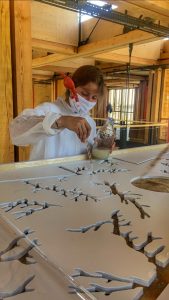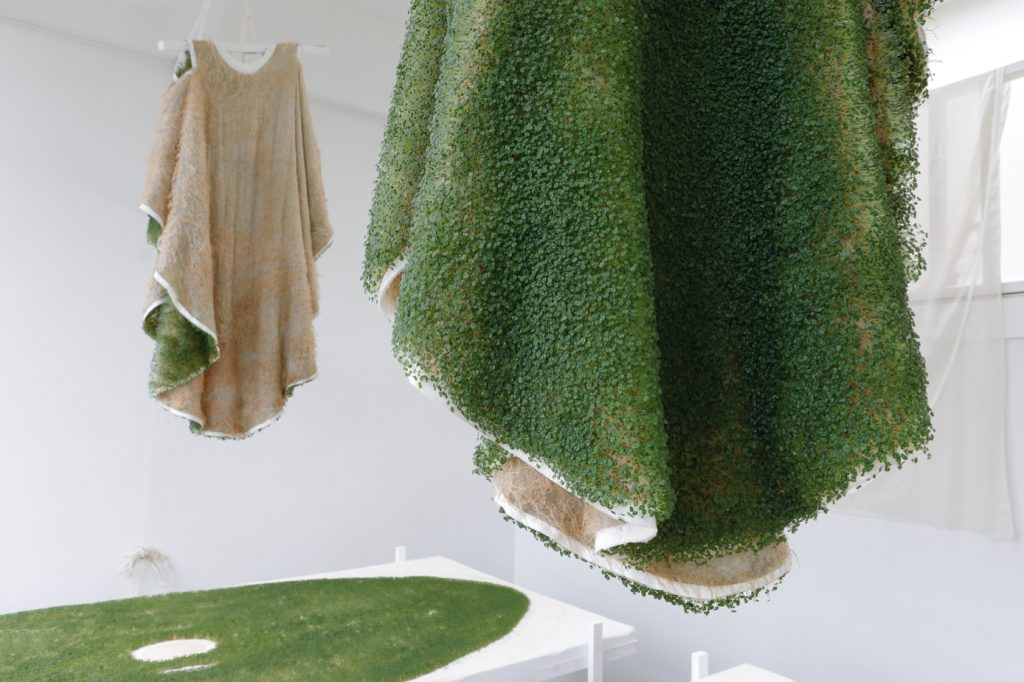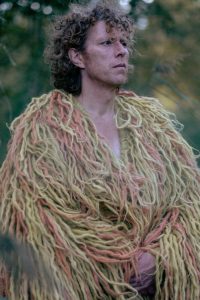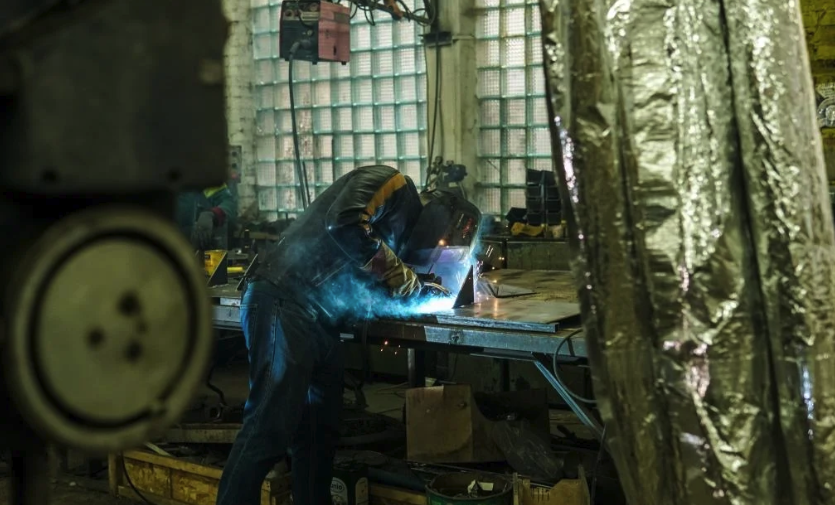» Blog » News » A hemp gunya and a raincoat sprouted from chia seeds that needs to be worn outside: how is that possible?
A hemp gunya and a raincoat sprouted from chia seeds that needs to be worn outside: how is that possible?
Daryna Tsapenko is a social designer, performer, and researcher in the field of biodesign. She obtained a Master’s degree in Social Design at the Eindhoven Academy of Design (NL). She worked as an artist in residence at the Jan Van Eyck Academie in Maastricht. In 2020, she received the Bio Art and Design Award.

Daryna researches mycelium and other biomaterials, as well as their application in the textile and fashion industries. For example, the raincoat that the designer grew from chia seeds or the gunya from mycelium which looks like a traditional Carpathian coat.
The artist organized exhibitions in Belgium, Germany, and the Netherlands which showcased unique and innovative pieces. Each of them carries a certain message to the world: be it a longing for one’s family home, a rejection of excessive consumerism, or a new idea of the spatial relationships between a person and the environment.
We talked to Daryna about the combination of biology, modern design, and art as well as about the problems of career opportunities for researchers in Ukraine.
From architecture to microbiology: why biodesign?

My field of activity is quite broad. Biodesign is more of a framework through which I view the universe. Everything developed quite organically: I did a lot of things in the field of architecture, worked with jewelry and interior design, but at some point I realized that not only appearance and function are important to me, but also the energy of life present in the materiality of something. Biodesign is what allows you to feel this energy: while working with living material, you co-create with nature. This process of co-creation usually activates your senses—from smell to intuition. I like this process.
You call yourself a performer. Tell us about your most outstanding projects.
When I studied in the Netherlands, I realized that architecture is interesting to me as a phenomenon, but I don’t see myself in this profession. Therefore, the performance was a tool to stay in architecture, although not directly, as well as explore something new.
For example, my graduation project at the Eindhoven Academy of Design was a performance installation. I depicted architectural geometric structures that mimic the movements of people in the process of dressing and undressing. Based on these designs, I created a collection of clothes, but not as something decorative, or even functional, but as clothes that represent the routine behind closed doors. Even now, I use elements of performance to explore processes in biodesign.
A hemp gunya and a raincoat sprouted from chia seeds that needs to be worn outside: how is that possible?
I started working on creating a raincoat from seeds during my studies. At the time, I did not take it seriously, but continued to experiment. This green coat is interesting because it is worn in the process of creation: it needs to be put on and worn in the rain, or watered like a plant. It is based on gauze made of vegetable fiber, on which I sift a layer of seeds. I pour water and a root booster on the seeds, and when they sprout, they cling to the gauze. It takes from 10 days to 3 weeks to make fur. The material is soft to the body and moist. At first, it feels a little unusual, because you feel that it is alive. Then the raincoat heats up and you feel the life energy of the plants. After wearing it, there are two options: either eat the “harvest” in a salad, and wear the dried roots, or bury it in the ground.


I made gunya from hemp fiber and mycelium. This is a technology that we developed together with Professor Han Wosten from Utrecht University. It is technical hemp that consumes various types of mushrooms. The mycelium connects the short fibers left after processing the hemp, thus creating strong textile fabrics. On the outside, it is a unique elastic material.
Last October, at the Dutch Design Week (the largest design event in Northern Europe), Daryna presented the Borscht Gunya. Its fibers were dyed with ingredients used to prepare borscht: beets, carrots, onions.
What are you currently working on?
Now I am studying the symbiotic relationship between beans and mushrooms, mycelium. Beans used to be one of the most important foods, but now beans are consumed much less in the Netherlands. At the same time, this plant is useful for the soil, because it saturates soil instead of depleting it. Basically, I grow a certain type of bean and create new recipes and objects from it, combining it with mycelium. Mycelium not only makes beans more digestible for the body through the fermentation process and increases the protein content of the product, but also makes beans a product of the future in every sense. Another aspect of this project is the promotion of a particular type of bean, typical for the Northern region of the Netherlands, Groningen, which is currently on the verge of extinction due to lack of demand.
Have you considered educational institutions in Ukraine?
In Ukraine, I obtained my Bachelor’s and Master’s degrees at the National Academy of Fine Arts and Architecture (NAOMA). Then I wanted to somehow expand my horizons. I considered the architecture schools in Denmark, Belgium, and finally chose the Design Academy in the Netherlands. I was interested in the Faculty of Social Design, about which I knew the least at the time and sought to deepen my knowledge.
There are many very high-class specialists working in Ukraine. Those are researchers with a good mindset who are eager to share and invent new things. However, the main currently existing problems are low funding for research and development and insufficient demand. Unfortunately, universities do not have the equipment that scientists need for their inventions and hypotheses. That is why many scientists go abroad, because they can apply their knowledge there. Currently, the possible ways of financing Ukrainian science are mostly grants.
In Europe, instead, a lot of money is invested in the design of something unknown. This is the guarantee for countries to be innovation leaders.
If the scientific research community in Ukraine was provided with sufficient finances and infrastructure, would it be possible to bring back specialists who went abroad?
I think it’s going to take some time. A certain platform should be created so that people have the motivation to stay and work in Ukraine. For example, it would take me much more time, effort, connections, and experience to achieve in Ukraine what I have now by studying and working abroad.
Already now, having certain knowledge and practical skills, I can bring it to Ukraine. My work policy lies in combining Ukrainian and Dutch achievements. Not only to bring expertise and innovations to Ukraine, but also to do the opposite. Undoubtedly, Ukraine has a lot of special things that we can teach and share with our colleagues in other countries. Then, in my opinion, a healthy exchange process takes place.
In Ukraine, first of all, it is necessary to improve the financial security of our scientists. One thing is knowledge, ideas. But the next step is to implement all of it. Furthermore, it is also about an awareness of the importance of collaboration between artists, designers, and scientists, as well as the ability to see potential for the future in this.
For instance, we can see on the example of Metalab how the Makerspace functions, and how CO-HATY was born from this. I believe that these are seeds from which something can grow. Therefore, you need to believe in them, plant, nurture and support their growth.

Such stories of young scientists in Ukraine are not uncommon. One of Promprylad.Renovation’s goals is to keep this unique potential in the home country. To this end, within the Promprylad.Renovation project, we strive to foster favorable conditions for Ukrainian researchers, develop Makerspace and expand spaces for research and experiments in Ivano-Frankivsk.